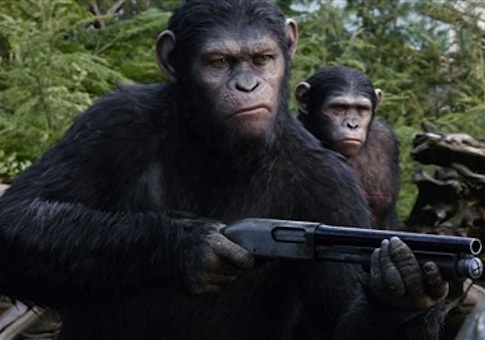As far as dystopian world-building goes, Dawn of the Planet of the Apes half-succeeds.
Set 10 years after Rise of the Planet of the Apes, the "Simian Flu" that broke out at the end of that film has left just one in 500 humans alive. Conflicts over food and other resources have further depleted the population. Indeed, humanity is so scarce that, as the film opens, ape-king Caesar (Andy Serkis, in a motion-captured performance) has not seen a homo sapiens for two years.
Caesar and his tribe of intelligent apes have made a home in the redwood forests outside San Francisco. They are learning to read and write, and have come up with some rudimentary (and familiar, to fans of the original series) rules: "Ape not kill ape" is right at the top. They live in Swiss Family Robinson-style tree houses, are learning to talk, and seem to be getting along quite nicely.
We also see them hunt. And in this early, bravura sequence—featuring dozens of apes swinging from trees, taking down deer and a ticked-off bear—we are shown how dangerous a group of intelligent apes can be. Strong, quick, and deeply protective of one another, these are not creatures to be trifled with.
Humanity, of course, has not been wiped out. And the reintroduction of man and ape does not go smoothly. A group of humans attempting to repair a dam in order to power a makeshift colony in downtown San Francisco comes into conflict with Caesar and his friends. Following a brief misunderstanding, involving a scared human and a gun, the apes allow the humans safe passage to conduct their repairs.
While the world building in Ape Town is quite good, we see very little of how the remnants of humanity are struggling to get by in San Francisco. We know they need power, but that’s about it. We don’t really see how people live; instead, we spend virtually all of our screen time in public spaces. A former military man named Dreyfus (Gary Oldman) is barely holding things together. He is willing to wage war on the apes if they cut off access to the hydroelectric dam. Malcolm (Jason Clarke) urges calm: There are so few humans left, he says, that conflict with the apes is a lose-lose proposition.
Malcolm and Caesar form a bond, tearing asunder their respective communities. Caesar’s top lieutenant, Koba (Tony Kebbell), does not trust the humans; similarly, Dreyfus does not trust the apes. Needless to say, the clash between the humans and the apes is as inevitable as it is sad.
It also devolves into cliché. There’s the hot-headed human who can’t help but spark a war, and the kid who demands to come on a dangerous mission just because, and the honorable doctor who saves a sick enemy in order to regain his trust. Given the originality of much of the rest of the production, the use of these narrative crutches occasionally grates.
Much is forgiven, though, because director Matt Reeves (Cloverfield, Let Me In) has an eye for striking images: A monkey perched on a pole as a tattered American flag flutters underneath him; two apes in a clinch as a fire rages behind them; an enraged chimp firing a M249 in each hand as he rides a galloping horse toward a human encampment.
Reeves’ camerawork also benefits from a choice to mostly ditch the shaky cam aesthetic that so dominates our action films. His shots are cleanly composed and coherently assembled, so the audience never feels lost or overwhelmed by the action.
